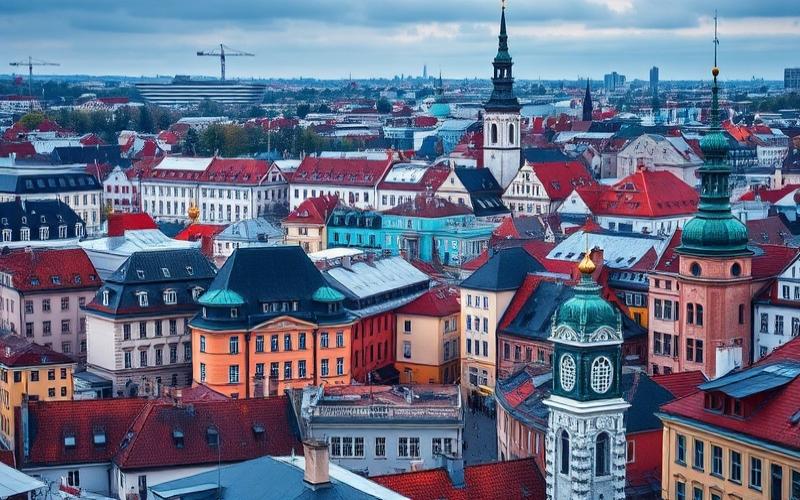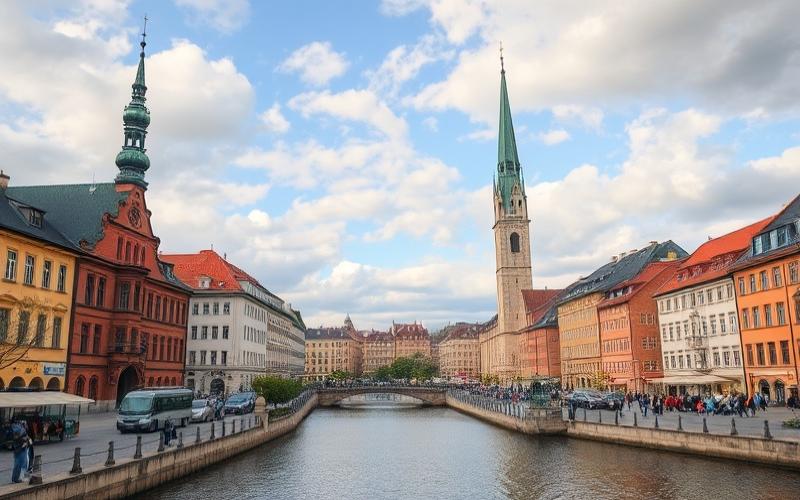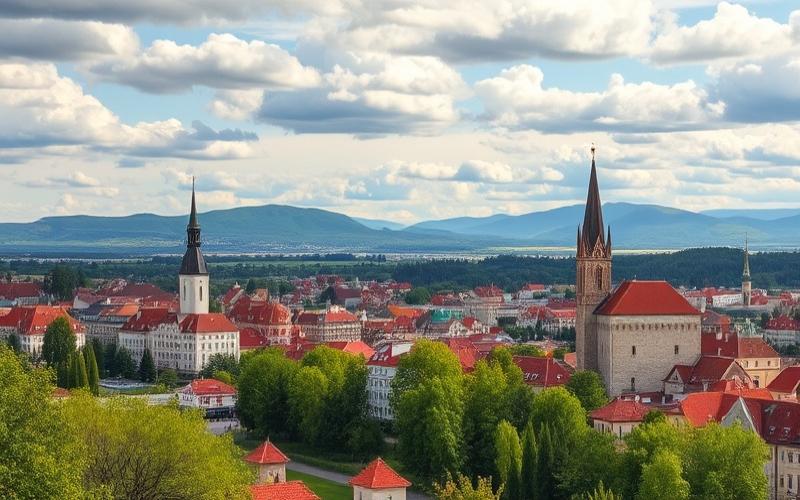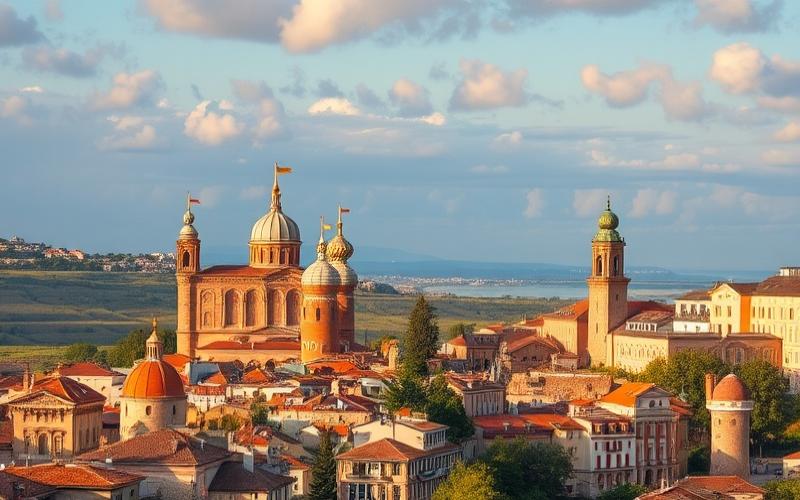
 Published on and written by Cyril Jarnias
Published on and written by Cyril Jarnias
Estonia, this small Baltic country nestled between the Baltic Sea and the Gulf of Finland, offers a unique culinary experience that reflects its rich history and diverse culture. For expatriates settling in this country, exploring the local cuisine is an exciting adventure that allows for full immersion into Estonian culture. This guide will take you on a journey to discover the authentic flavors of Estonia, from traditional markets to iconic restaurants, including the new culinary trends enlivening the country’s food scene.
The Foundations of Estonian Cuisine
Estonian cuisine is deeply rooted in its history and environment. Influenced by the many nations that have ruled this region over the centuries, it has maintained its authenticity while incorporating elements from Danish, German, Swedish, Polish, and Russian cuisines.
The basic ingredients of Estonian cuisine are simple but flavorful: pork, fish (particularly eel and herring), potatoes, dairy products, and a variety of grains. Estonian forests also provide an abundance of wild berries, mushrooms, and herbs that add a unique touch to local dishes.
Black bread, or “must leib,” holds a central place in the Estonian diet. This dense, slightly sour rye bread is not only a staple food but also a strong cultural symbol. Estonians consider it a sacred element of their culinary heritage.
Dairy products, particularly cheese and butter, are omnipresent in Estonian cuisine. “Kohuke,” a small fresh cheese coated in chocolate, is a popular snack you’ll find in every supermarket across the country.
Good to know:
Estonian cuisine is characterized by simple yet pronounced flavors, with a preference for smoked, pickled, and fermented foods. Don’t hesitate to try “sült” (meat jelly) or “hapukapsas” (sauerkraut) for a true immersion into local flavors.
Iconic Dishes to Discover
To truly appreciate Estonian gastronomy, it’s essential to taste its iconic dishes. Here’s a selection of specialties that every expatriate should try:
1. Verivorst: This blood sausage is a Christmas season staple. Served with applesauce and sauerkraut, it embodies Estonian culinary tradition.
2. Kiluvõileib: This anchovy spread on black bread is a popular snack you’ll find in many cafes and bars.
3. Rosolje: This beet, potato, and herring salad is a classic on Estonian tables, particularly enjoyed during celebrations.
4. Kama: This flour made from roasted and ground grains is often mixed with yogurt or milk to create a nutritious dessert or breakfast.
5. Kohuke: This small fresh cheese coated in chocolate is a snack beloved by Estonians, available in a variety of flavors.
These dishes are just the tip of the Estonian culinary iceberg. Don’t hesitate to explore further and taste specialties like “kartulisalat” (potato salad), “seljanka” (hearty soup of Russian origin), or “leivasupp” (sweet bread soup).
Good to know:
Estonian cuisine varies by season. In summer, light dishes based on fresh products are preferred, while in winter, heartier and more comforting foods are favored.
Traditional Markets: A Dive into Authenticity
To truly grasp the essence of Estonian gastronomy, nothing beats a visit to traditional markets. These vibrant places not only offer the opportunity to discover a wide variety of local products but also to immerse yourself in the country’s culinary atmosphere and traditions.
Tallinn Central Market, located in the Kesklinn district, is a must-visit. Housed in former zeppelin hangars, this market offers an impressive variety of fresh products, smoked meats, fish, cheeses, and artisanal breads. It’s the ideal place to find authentic ingredients and interact with local producers.
Balti Jaam Market, recently renovated, offers a more modern experience while retaining its authentic charm. Besides fresh produce stalls, you’ll find numerous street food stands offering Estonian and international specialties.
For expatriates living outside Tallinn, local markets in cities like Tartu, Pärnu, or Narva are equally interesting to explore. They often reflect regional specificities and offer a more intimate experience.
During your visits to these markets, don’t hesitate to taste seasonal products. In summer, wild berries (blueberries, lingonberries, raspberries) are particularly appreciated. In autumn, fresh mushrooms take center stage. Winter is the ideal season to discover smoked meats and homemade preserves.
Good to know:
Markets are often the ideal place to find artisanal products like local honey, homemade jams, or dried herbs used in traditional Estonian cuisine. Don’t hesitate to ask vendors for advice, as they’ll be happy to share their knowledge.
Iconic Restaurants: Between Tradition and Modernity
Estonia, and particularly its capital Tallinn, is experiencing a true culinary renaissance. Estonian chefs, proud of their culinary heritage, are reinventing traditional recipes with a touch of modernity and innovation. For expatriates wanting to discover local gastronomy in a more formal setting, here’s a selection of must-visit restaurants:
1. Olde Hansa (Tallinn): Located in Tallinn’s Old Town, this restaurant offers a true immersion into medieval Estonian cuisine. The servers in period costumes, candlelit atmosphere, and ancestral recipes will transport you back in time.
2. Leib Resto ja Aed (Tallinn): This restaurant focuses on local and seasonal products. Its name, meaning “bread” in Estonian, reflects the importance of this food in local culture. The menu changes regularly to adapt to available products.
3. Põhjaka Manor (Järva County): Situated in a former manor, this restaurant offers modern Estonian cuisine prepared from products grown on-site or sourced locally. It’s the ideal place to discover Estonian gastronomy in a pastoral setting.
4. Ööbiku Gastronoomiatalu (Rapla County): This gastronomic farm offers a unique culinary experience, highlighting products from the farm and surrounding area. Menus change daily based on harvests.
5. Rataskaevu 16 (Tallinn): This restaurant offers contemporary Estonian cuisine in a warm setting. It’s the ideal place to discover modern versions of traditional dishes.
These restaurants are just a glimpse of Estonia’s rich food scene. Don’t hesitate to explore other establishments, particularly in cities like Tartu, Pärnu, or Narva, each offering their own regional specialties.
Good to know:
Reservations are often necessary in popular restaurants, especially on weekends. Don’t hesitate to mention your dietary preferences or restrictions when making reservations, as Estonian restaurants are generally very accommodating.
Contemporary Culinary Trends
Although deeply rooted in its traditions, the Estonian culinary scene is constantly evolving. Estonian chefs, often trained abroad, return home with new techniques and ideas they apply to local ingredients. This fusion between tradition and innovation gives rise to unique culinary experiences that expatriates shouldn’t miss.
Nordic-Baltic cuisine is a major trend. It emphasizes local ingredients, traditional preservation techniques (smoking, fermentation), and minimalist presentation. Restaurants like NOA Chef’s Hall in Tallinn are at the forefront of this movement.
The farm-to-table movement is gaining popularity. Many restaurants, like Põhjaka Manor, grow their own ingredients or work closely with local producers. This approach ensures product freshness and supports the local economy.
The rediscovery of forgotten ingredients is another interesting trend. Passionate chefs are exploring the use of wild herbs, forest berries, and ancient vegetables in their creations. The restaurant Juur in Tallinn is renowned for its innovative use of these ingredients.
The craft brewery scene is booming in Estonia. Beers with unique flavors, often inspired by local traditions, are worth discovering. Põhjala Brewery in Tallinn offers tours and tastings that will delight beer enthusiasts.
Specialty coffee shops are multiplying in major cities, offering high-end coffee tasting experiences. Establishments like Renard Coffee in Tallinn offer carefully selected coffees prepared with expertise.
Good to know:
Estonia regularly organizes culinary events like Tallinn Restaurant Week or Tallinn Coffee Festival. These events are excellent opportunities for expatriates to discover the diversity of the local culinary scene.
Understanding table etiquette is essential for expatriates wanting to fully integrate into Estonian society. Although Estonians are generally relaxed about formalities, certain rules and expectations remain, particularly in more formal contexts.
In a family or friendly context: – Estonians are generally punctual. Arrive at the indicated time for dinner. – It’s common to bring a small gift to the host, such as flowers, wine, or chocolates. – Wait for the host to invite you to start eating before serving yourself. – It’s polite to taste all the dishes offered, even in small quantities. – Conversations during meals are generally calm and composed.
In a professional context: – Business lunches are common and often more informal than dinners. – Avoid talking business immediately. Wait for your host to bring up the subject. – It’s customary to split the bill, unless the invitation clearly specifies who’s paying. – Alcohol is generally avoided during business meals, unless your host offers it.
In a formal context: – In upscale restaurants, service may be more formal. Follow your host’s or local guests’ example. – It’s common to make a toast before drinking. “Terviseks” (to your health) is the most used expression. – Avoid placing elbows on the table during the meal. – It’s polite to finish your plate, but don’t force yourself if the portion is too large.
General tips: – Estonians appreciate quiet during meals. Avoid speaking loudly or making too much noise with your cutlery. – It’s common to wish “Head isu” (bon appétit) before starting to eat. – In restaurants, it’s customary to leave a tip of about 10% if the service was satisfactory.
Good to know:
Estonians are generally understanding toward foreigners who don’t know all the subtleties of local etiquette. Don’t hesitate to politely ask if you have doubts about how to proceed in a particular situation.
Finding International Ingredients
Although discovering local cuisine is an exciting part of the expatriate experience, it’s natural to sometimes want to cook dishes from your home country. Fortunately, Estonia, and particularly Tallinn, offers increasingly more options for finding international ingredients.
Specialized supermarkets: – Stockmann, in Tallinn, offers a wide range of international products, including Asian, Mediterranean, and American items. – Prisma, a Finnish chain present in Estonia, also offers a good selection of international products.
Ethnic markets: – Tallinn Central Market includes several stalls offering international products, particularly spices and Asian ingredients. – Russian grocery stores are present in many cities and offer products specific to Russian and Eastern European cuisine.
Online stores: – Sites like Barbora.ee or Rimi.ee offer home delivery and have a section dedicated to international products. – Amazon.de delivers to Estonia and can be a good option for specific products difficult to find locally.
Organic and natural product stores: – Stores like Biomarket or Ökosahver offer a selection of organic and natural products, including vegetarian and vegan alternatives.
Asian stores: – Several Asian grocery stores are present in Tallinn, offering a wide range of Chinese, Japanese, Korean, and Southeast Asian ingredients.
Gourmet food stores: – Shops like Kaubamaja Toidumaailm in Tallinn offer gourmet products from around the world, perfect for special occasions.
Remember that some ingredients may be difficult to find or more expensive than elsewhere. It can be useful to learn to use local substitutes or ask friends or family to send you specific products from your home country.
Good to know:
Expatriate communities on social media are often an excellent source of information for finding specific ingredients or local alternatives. Don’t hesitate to join these groups to exchange tips and advice.
Conclusion: Embracing Estonian Culinary Diversity
The culinary adventure awaiting expatriates in Estonia is both rich and exciting. From the rustic simplicity of traditional dishes to the innovation of contemporary cuisine, including the freshness of local products, Estonian gastronomy offers a unique palette of flavors worth exploring in depth.
As an expatriate, immersing yourself in the local culinary culture is one of the most rewarding ways to understand and appreciate your host country. Whether by frequenting local markets, tasting specialties in traditional restaurants, or participating in culinary events, each experience will bring you closer to Estonian culture.
Remember that food is a universal language. Sharing a meal is often the best way to create bonds with locals and other expatriates. Don’t hesitate to organize dinners where you can exchange your respective specialties, thus creating bridges between cultures.
Finally, keep an open and curious mind. Estonian cuisine may sometimes surprise with its flavors or unusual ingredients, but it’s precisely this originality that makes it charming. Every dish, every ingredient tells a story—that of a resilient people who have preserved their traditions while embracing modernity.
Your culinary journey in Estonia is just beginning. Bon appétit, or as they say in Estonian, “Head isu”!
Good to know:
Cuisine is constantly evolving, even in Estonia. Don’t hesitate to regularly revisit your favorite restaurants and explore new establishments. The Estonian culinary scene might well surprise you with its constant innovations.
Disclaimer: The information provided on this website is for informational purposes only and does not constitute financial, legal, or professional advice. We encourage you to consult qualified experts before making any investment, real estate, or expatriation decisions. Although we strive to maintain up-to-date and accurate information, we do not guarantee the completeness, accuracy, or timeliness of the proposed content. As investment and expatriation involve risks, we disclaim any liability for potential losses or damages arising from the use of this site. Your use of this site confirms your acceptance of these terms and your understanding of the associated risks.
























